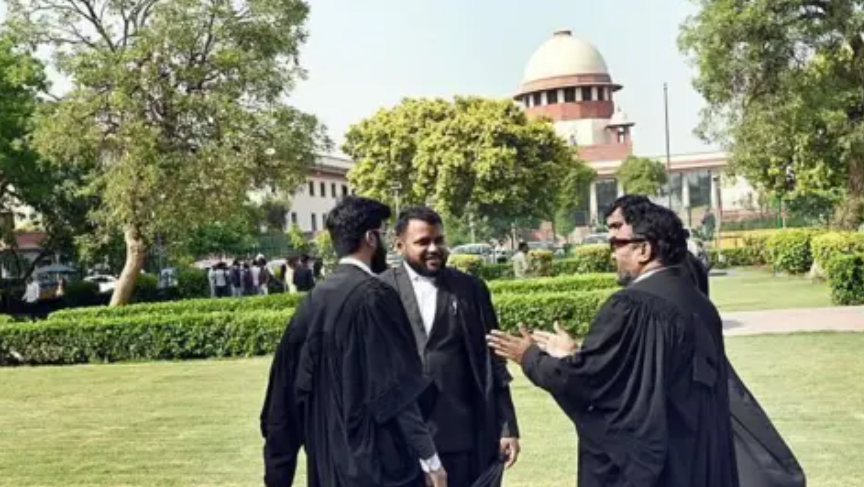

India recently appointed new judges to the top court and some high courts. But the list has very few women.
In September 2021, a photograph from the Indian Supreme Court of then chief justice NV Ramana flanked by his four female colleagues went viral.
This was the highest-ever tally of female judges in the 34-member top court and was hailed as a "historic moment".
Many saw it as a turning point for India's top judiciary and expressed the hope that it would start reversing the skewed gender gap in India's top court.
But four years later, that hope lies in tatters and the Supreme Court is back to being – as lawyer Sneha Kalita described it - "a men's club".
Three of the women seen in that photograph with Justice Ramana - Justice Indira Banerjee, Justice Hima Kohli and Justice Bela M Trivedi – have since retired.
And as no woman has been appointed to the top court since then, Justice BV Nagarathna is now the sole female judge there.
"This is alarming. It's nothing short of catastrophic," Ms Kalita, a member of an association of female advocates who have filed a petition in the Supreme Court demanding fair representation of women in courts, told the BBC.
Historically, Indian judiciary has been dominated by men. From 1950, when the Supreme Court came into existence, it took 39 years for Justice Fathima Beevi to be appointed the country's first female judge in 1989.
"I opened a closed door," she told news website Scroll in 2018. But in 75 years, the court has welcomed very few women – only 11 out of the 287 judges or a measly 3.8%.
"With just one woman, we are back to near-zero representation in the top court. This has become a men's club," Ms Kalita says.
What is also troubling is that there are only 103 female judges compared with 670 males in the high courts - and at least four do not have a single woman.
This low representation of women has come into sharp focus in recent weeks after the latest batch of appointments was made to the Supreme Court.
The court had two vacancies to fill and it was expected that the Supreme Court collegium - which includes the chief justice and four senior-most judges and recommends names to the government - would use the opportunity to correct the acute gender imbalance.
But in August-end, two high court judges - both male - were elevated to the role. Media reports say that at least three female high court judges in the country were senior than one of the elevated judges.
The collegium's other recent selections have also ignored women - Bombay High Court last week got 14 new judges, but only one was woman. For Allahabad High Court, the proposed list of 26 candidates includes only five women.
This low representation of women in the top court as well as "in high courts across the country" prompted the Supreme Court Bar Association (SCBA) to put out a strong statement expressing "deep disappointment" and "grave concern".
SCBA president and senior lawyer Vikas Singh told the BBC that "women make for 40% of all judges in lower judiciary, that is district courts and below, where recruitments are on merit and candidates are chosen through written exams and interviews".
"But in higher judiciary where they are selected by the collegium, they make for less than 10%. Something very drastic needs to be done. Effort must be made to look for more women," he said.
Most women lawyers the BBC spoke to welcomed the SCBA intervention. "I'm glad the bar association has raised it, it's not a women's problem. It reflects on us as a society," said senior lawyer Madhavi Divan.
It's not that all women judges are more gender sensitive - in the past, the BBC has reported on equally misogynistic judgements by male and female judges.
But senior Advocate Jayna Kothari says India is a diverse country and diversity is important for judiciary too.
"Supreme Court is for the entire country so it chooses judges from different high courts to reflect regional diversity. So, why not gender diversity? Women represent 50% of India's population so they should have an equal representation in the judiciary too."
Different life experiences, she says, allow people to respond differently to a case which means that having people from diverse backgrounds will lead to better judicial outcomes and help get better judgments.
Ms Kothari says studies also show that the mere presence of women on the bench stops other judges and lawyers from making gender insensitive comments.
But the question still remains: how to get more women judges?
Some have suggested a quota system - where a certain number of seats are reserved for women. They say this would force the judiciary to put its house in order. But critics say that could lower the standards as reservation and merit are contradictory.
Ms Kalita disagrees – women judges and lawyers, like women everywhere, work harder, balancing home life and childcare with careers, she says.
"Many women are much more meritorious than male colleagues. You can't brush us aside just because we are women. This is discrimination," she adds.
Ms Kothari says the skewed gender ratio "must be seen as an important public issue, not just as a women's issue" and that we must aim for 50% but can start with a more realistic goal of 30% in the next five years.
"It should be a matter of pride to appoint women to higher judiciary. Having more women in the high courts and the Supreme Court will also encourage more women to join the legal profession and stay on.
"Otherwise many women would think what's the point of slogging so hard if we are not going to be be able to reach the top?" she asks.












